Ignoring the traditional style boat shoe, sailing sandals, and even womens sailing shoes for the moment, Practical Sailor acquired mens athletic-style boat shoes (deck shoes), from numerous purveyors of sailing apparel. We chose the models we felt were most applicable to mainstream sailing activities on both wet and dry surfaces. Testers assessed each pair of sailboat shoes with non-marking soles for best grip, comfort, construction, foot protection, grip, weight, performance, and absorption. In our quest for the best boating shoes, several marine performance shoes climbed to the top. Several could clearly be classed as racing shoes that might not appeal to cruising sailors.
***
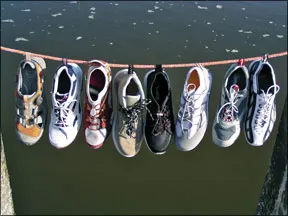
Whether cruiser, racer, or recreational daysailor, most of us rely on boat shoes in the same way we depend on a good knife or PFD&emdash;as indispensable tools for our time spent on board. That, coupled with the fact that it has been far too long since a review of sneaker-style boat shoes appeared in these pages (almost a decade), we offer this report.
In that evaluation (
Practical Sailor Oct. 15, 1998), we surveyed 11 models from six companies and found that we preferred those from Harken and Rockport. These days, there are more players and more buyer options. Even as we prepared this article, several participating companies were set to launch new models expected to hit store shelves shortly after this issue gets to you.
Practical Sailor
acquired mens athletic-style boat shoes from several purveyors: Boaters World, Sperry Top-Sider, Harken Yacht Equipment, Timberland, Helly Hansen, Sebago, Rugged Shark, and Slam. All of these companies make more than one model of shoe, so we chose those we felt were most applicable to mainstream sailors.
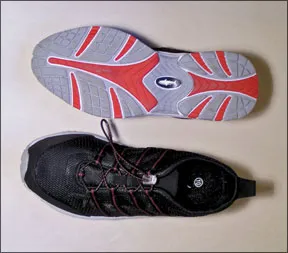
Against the Elements Hydra II
Sea Bowld (an in-house brand from Boaters World) makes a number of apparel products marketed under the Against the Elements label, including shoes. The Hydra II model has an all-mesh upper with panels of synthetic leather sewn at the toe and heel and 3/8-inch nylon webbing straps stitched along the body for reinforcement. The laces&emdash;1/8-inch bungee cord tightened by way of a spring-loaded locking slider&emdash;run through loops stitched into the webbing.
This is one of three models
Practical Sailor tested whose tread patterns don’t include conventional siping. Instead, Sea Bowld uses gum rubber formed in a series of different-sized, raised panels with large channels dissecting them in several directions. And unlike all the other shoes we tested, the footbed on the Hydra II is not removable, but is glued in place. Made in China, the Hydra II is the least expensive product we tested ($20) and is offered only in whole sizes.
Bottom Line:
One of the least comfortable products tested, and it affords the least foot protection. But its hard to resist the price&emdash;about one-fifth of the other shoes tested. The drainage and grip are good, so its our Budget Buy.
Harken Vortex
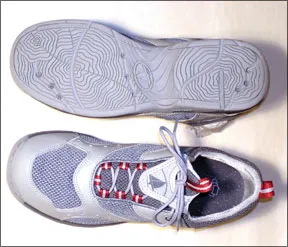
Like many of the companies in this test, Harken Yacht Equipment offers several different models of athletic-style sailing shoes. The company sent us four: Vortex, Valencia, Trimmer, and Speed Grip, the last of which has been discontinued. We opted to test the Vortex, which had a very comfortable fit. The supple upper is constructed as one piece (the tongue is integral), using a mesh and neoprene sandwich. The shoe, which is made in China, is outwardly reinforced with bands of synthetic leather sewn to the upper and a hard plastic heel. The mesh in the upper section promotes drainage, and the shoe features nine small wire-mesh holes in the sole for the same function.
The Vortex laces, once tied, can be tucked into a small neoprene pouch on the tongue to keep them from being snagged. The removable EVA foam footbed has strands of silver woven into it, which the company claims are antibacterial. The company also claims that this component offers “shock absorption, neutral pronation, and all-day comfort.”
Instead of conventional siping on the sole, Harken has devised a system it calls Radial Traction Zones with recessed channels resembling lines on a topographic map. The company literature claims this system offers wearers “360-degree directional grip.” In our grip test, it was one of the best on wet teak. (Harken cautions users that these shoes are only for use on boats; street use will diminish the gripping ability.) The single-piece outer sole purportedly offers control of ankle and foot rotation.
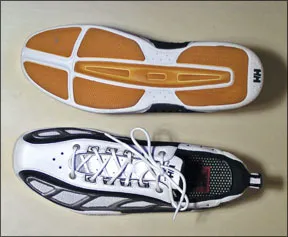
Bottom Line:
The Vortex was one of the best for comfort, but its lacking in arch support. This shoe drains well (absorbed only 4 ounces of water) and would be reasonably cool in warm weather. The Radial Traction system fared well in all aspects of our incline test except on dry teak. Its well-engineered and well-built and earns our Recommended rating.
Helly Hansen Hydrator Breathe
Helly Hansen, a company based in Norway, has been making performance outdoor gear since 1877. Judging by the samples we received&emdash;five different models of sailing shoes&emdash;its designers seem to have departed from their venerable heritage by incorporating high-tech components and materials as well as what we guess is their take on contemporary fashion. Euro-styling distinguishes four of the pairs we received, leaving them to resemble bowling shoes or something akin to what Michael Jordan wore in his early NBA years. Admittedly, style is an ultra-subjective topic, so if its comfortable, protects the feet, and grips the deck, were not overly worried about appearance.
Made in Vietnam, the Hydrator Breathe comes in several styles and colors. The upper is made primarily of synthetic leather fashioned around a soft mesh body with stiff plastic and nylon reinforcing. The soft mesh and two wire-mesh holes in the outer sole allow drainage and air flow. According to the company, the Hydrator Breathe “is built with the warm-weather sailor in mind,” so it is also fit with an odor-absorbing sock liner, an anti-bacterial microfiber midsole cover, and a removable foam-based footbed.
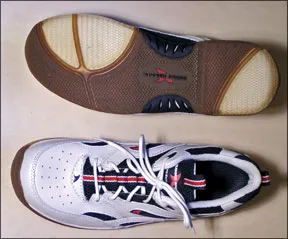
The sturdy, one-piece, gum rubber outsole has six recessed sections into which the five siped panels are located. Helly Hansen has trademarked this as Storm Grip. All the Helly Hansen shoes we received came with a nylon carry bag and an extra set of laces.
Bottom Line:
Both testers felt these shoes were constricting. And both felt it lacked arch support and toe protection, but did offer good stability. The Hydrator Breathe performed very well on our incline tests; however, we can’t recommend a product that wearers wont be apt to wear for prolonged periods.
Rugged Shark Aquaire Tie
Based in Fort Lauderdale, Fla., Rugged Shark has been supplying the boating market with shoes of its own design since 1997.
Practical Sailor tested the Aquaire Tie shoe (the company also offers a slip-on version).
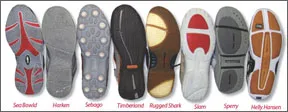
This product is made of real leather uppers with nylon mesh windows for drainage. To construct the uppers, the company uses 12 different panels of leather. Where leather meets leather, the seams are double-stitched; where leather meets mesh, the seams are single-stitched. The laces are standard nylon strands.
The Aquaire Tie comes with a removable footbed made of foam and nylon seamed together. Its perforated to enable drainage. (See detail photo, page 39.) The sole is made of medium-density rubber formed into siped panels that are separated by 1/4-inch channels. The siped sole is carried up onto the toe and the heel for better footing in those awkward stances sailors often find themselves in.
Bottom Line:
A basic sailing shoe that offers limited comfort yet good protection. It didnt grip well on our fiberglass panel, and testers thought it would prove hot in warm weather. At almost the same price as some better shoes ($80), wed pass.
Sebago Wave Extreme
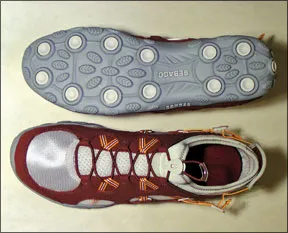
Established in New England in 1946, Sebago is now part of a conglomerate called Wolverine World Wide, a supplier specializing in boots and shoes. We received two pairs of Sebago shoes, the performance-oriented Wave Extreme and the more mainstream Siphon series Canal. The latter has been discontinued, but other styles in its series are still available.
The Wave is available in four versions (Verge, Outflow, Extreme, and Leather). The Extreme comprises a unibody Lycra neoprene-and-mesh sock upper reinforced with a synthetic leather outer skeleton that is double-stitched to the sock. The bungy-cord laces cinch up by way of a plastic cam with a sliding sprocket that locks on the cord. The nylon webbing runs back through buckles on either side of the shoe, enabling the wearer to further cinch the upper around the ankle for a snug fit. This water-sock approach allows wearers more of a feel for the deck, a feeling akin to being barefoot.
Sebago has trademarked the unibody sole, fabricated from gummed rubber, as the Octopod system, which has 12 suction-cup recesses and 40 raised ovals. It is the most distinctive of all the tread systems
Practical Sailor tested. The Wave shoes also have removable antibacterial EVA foam footbeds (perforated for drainage). These footbeds come with a removable nylon sock that can be washed or replaced.
Bottom Line:
The Wave Extreme was far too snug around the ball of the foot, though it felt better without socks. The laces are easily adjusted to achieve even tension (though they need a larger locking device), and the shoe is stable, drains reasonably well, and offers a fairly good grip. But it lacks toe protection&emdash;something Sebago has better addressed with its Siphon series, a line geared more toward performance sailors. We think there are more comfortable models than the Wave Extreme available for roughly the same money ($90).
SLAM Match Race
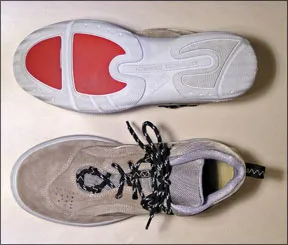
The Italian-based Slam, a sportswear manufacturer that has been in business since 1979, makes seven models of sailing shoes. We tested the Match Race, described as a “technical sailing shoe.” Slams shoes have gained a particular foothold in the grand prix racing market, which
Practical Sailorconsiders a qualified endorsement, but one that comes with a caveat: Many products preferred by racers offer superior performance yet also carry a superior price tag. At $130, the Match Race shoes were the most expensive pair we tested.
The upper sections of the Match Race are made from suede panels stitched over foam thats covered with a proprietary mesh fabric Slam calls Tora and advertises as “breathable.” Every seam is double-stitched.
The Match Race, which is made in Italy and comes in four colors, has a unibody sole made up of siped sections under the ball and heel, with larger grooved sipes rimming the periphery. This is the one product
Practical Sailor tested where the stitching connecting the sole to the uppers was not visible and therefore better protected from wear. It is also the only test product to have reflective tape sewn on it (upper heel). The Match Race also has a removable, antibacterial, latex foam footbed that also contains “active coals to absorb bad smells,” and has been treated with the “essence of perfume,” according to Slam.
Bottom Line:
Superb comfort with a superior grip and admirable foot protection, this shoe has two Achilles heels&emdash;drainage (it retained 7 ounces of water and is the only model whose foam footbed absorbs water) and price. If money isn’t an object, you can’t go wrong here.
Sperry Top-sider Figawi
2
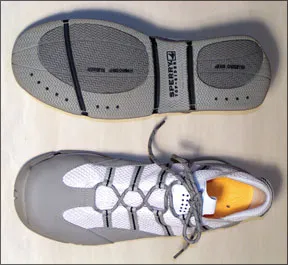
Established in 1935, Sperry Top-Sider is a company whose name is nearly synonymous with deck shoes. Now a division of Stride Rite Corp., the company offers five athletic-style sailing shoes. The company calls the Figawi2 model a “technical performance sailing shoe.” The Figawi2, made in China, comes with synthetic leather uppers or mesh uppers, and it comes in five colors. We tested a mesh pair.
Aside from the mesh uppers, there are eight holes between the upper and the sole to promote drainage and minimize water absorption. We found that this shoe drains very fast; it turned out to be the only product we tested with drainage in the heel.
Sperry uses a proprietary material it calls HydroGrip Rubber for the sole, which is formed with siped channels approximately 3 millimeters apart. The sole is segmented into four areas by larger channels that run widthwise across it. Sperry has trademarked this system as the Quadro Grip, and claims that it offers improved traction, wet or dry. The Figawi2 also includes a removable EVA foam footbed, and what the company has trademarked as an AEGIS microbe shield for odor control.
Bottom Line:
The least absorbent of all the shoes we tested and quick-draining. Comfortable enough to wear all day with good toe and heel protection and reasonable arch support. Though it was the worst performer on our nonskid panel, we still feel it would be a good shoe on shore and offshore, so we recommend it.
Timberland Eurus

0)]
Headquartered in New Hampshire, Timberland has been making boat shoes since the late 1970s. We tested the Timberland Eurus, which the company labels a “high-performance sailing shoe.”
Made in China, the Eurus is the lightest shoe we tested as it is really a hybrid, shoe-sandal, intended primarily for warmer climates. (Wearing without socks is recommended.) The uppers are made of waterproof leather integrated with a lightweight neoprene-mesh fabric. For snugging the upper over the foot, Timberland employs a multi-adjust lacing system, which uses a wire and a knob that tightens the wire. To improve stability, the company embeds a hard plate in the outer sole under the heel. For enhanced grip, the Eurus has broad, undulating tread that wraps well up the toe and heel.
Bottom Line: The most comfortable shoe with one of the best gripping soles we tested. It offers good arch support, toe and heel protection, and stability. The innovative, low-profile lacing system still has to prove itself, but we like the concept. Its only drawback is lack of insulation for cold-weather use, so it is the Practical Sailor Best Choice.
Conclusions
These are all good products, but we conducted our evaluations with an emphasis on comfort. Admittedly, this is a subjective area, but you can’t understate the importance of comfort as criteria. If you can’t wear a shoe for long because it doesn’t feel good on your foot, then it doesn’t matter how well it drains, grips, or repels odor. The shoes that rose to the top in this evaluation&emdash;Harkens Vortex, Slams Match Race, Sperrys Figawi2, and Timberlands Eurus&emdash;are all very comfortable and all have malleable upper sections that don’t require breaking in.
That said, none of these products is perfect. With the exception of Sperrys Figawi2, all shoes tested will retain water in the heel section, and some, like the Vortex could use more arch support. Slams Match Race needs better drainage and a more earth-bound price. And, of course, there are other products out there that we didnt test. Models from Teva, Columbia, and Merrill come to mind.
Because no particular shoe is right for all sailors, we suggest that anyone in the market for sailing shoes should use our findings to narrow the options and then try on the products before purchasing.


































